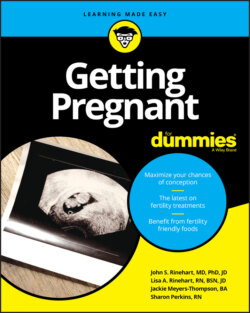Читать книгу Getting Pregnant For Dummies - Sharon Perkins - Страница 14
Making babies: An inefficient process at best
ОглавлениеYou may think of Mother Nature as a pretty efficient woman, and for many women that is true. One common misperception is that a woman has a 20 percent chance of conceiving each month she tries. That is simply not true. The chance of conceiving depends upon a woman’s age and how long the woman has been trying to get pregnant.
Unfortunately, as you go through this book, you will hear way too much about how age reduces a woman’s chance of conceiving. We all wish this weren’t true, but aging is an inevitability of life. Common sense should tell you that a 44-year-old woman has less of a chance of conceiving than a 24-year-old woman. But a subtlety of infertility is that there are actually three sub-groups within any group of people who start to try to achieve a pregnancy. The majority do not have a problem achieving a pregnancy, a small group are sterile, and an intermediate group are subfertile, meaning they will conceive, just not within the one-year time frame or without technology helping.
Women with normal fertility will conceive quickly. Some estimates place the chance of conceiving in the first month of trying as high as 40 percent. After three months, 65 percent of women who conceive naturally are pregnant, and by six months, 85 percent are pregnant. After that the chance of achieving a pregnancy gets less and less each month because those not getting pregnant easily have a greater chance of being subfertile or sterile. This is true regardless of age. So a 40-year-old female with normal fertility will get pregnant quickly. It’s just that by age 40 as many as 40 percent are functionally sterile. Looking at 100 women under age 35 trying to get pregnant, the breakdown looks like this:
Eighty-five will be pregnant within one year.
Ten more will be pregnant after two years of trying without medical intervention.
Five won’t get pregnant without some help from the medicine man or maybe not at all.
High-tech infertility treatments, such as in vitro fertilization (IVF), claim a success rate of about 50 percent for those under age 35. But people using IVF have the diagnosis of infertility, and even if they use IVF multiple times, some will never achieve a pregnancy. Estimates of the cumulative live birth rate for women under the age of 35 is about 85 percent, meaning that if women under the age of 35 try multiple cycles of IVF, 15 percent will never conceive and have a child that is genetically theirs.
